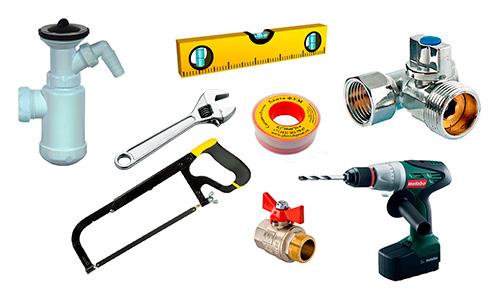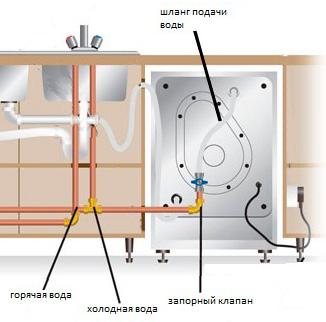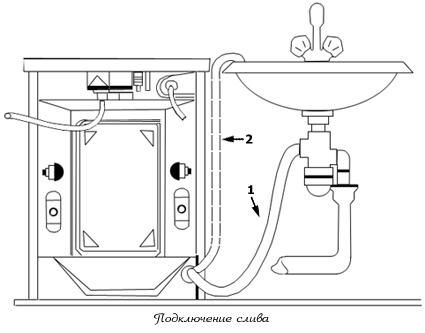Buying a dishwasher is a joyful event for all households, since it is from this day on that the question of who will wash the dishes will disappear in the house. Now this task will be handled by smart technology. But for it to work, dishwasher needs to be properly installed. How is the dishwasher connected to the water supply and sewerage? This question is very important, so we will give you the most detailed step-by-step instructions.
Preparing to connect the dishwasher

In order to connect the dishwasher to the water supply and sewerage, you need to prepare a little. We will break the whole process into several stages:
- Collection of tools and necessary materials;
- Preparation of a place for installing a dishwasher;
- Thinking through the connection to the water supply;
- Thinking through the connection to the sewer;
- Connecting to the mains and testing the dishwasher.
The most important thing is to choose tools and materials.
Connecting a dishwasher to the water supply is fraught with a number of difficulties. If you have never done plumbing work before, you will have to learn this on the go.Fortunately, progressive mankind has invented a lot of devices to simplify this task. For example, there are special pads for sale on the market, with which you can do without cutting. Also in the stores are numerous tees, taps and manifolds.
Connecting to the sewer is a little easier, but you still need skill. You will also have to change the siphon, although in the simplest case, you can get by with throwing the drain hose into the sink.But we advise you to do without such half-measures. Do everything in good faith, and do not leave imperfections Everything that is temporary stays that way forever.
What do we need from the tools?
- Hacksaw for metal - we will cut metal and plastic pipes with it;
- Drill - useful if you need to make a tie-in using an overhead tee-bandage;
- Wrenches - for tightening nuts;
- Tools for working with plastic pipes - necessary for soldering pipes;
- Winding (fum-tape, linen cord, sealants) - for reliable connection of individual elements.
Also for self-connected dishwasher we will need materials - a tee tap, a faucet without a tee, a manifold, a tee-bandage, additional pipes, drain and inlet hoses (if suddenly they were not included), a siphon with a pipe and an electrical outlet. No need to immediately run for all this to the store - some materials may not be useful to you.
Connecting the dishwasher to the water supply

Let's start connecting the dishwasher to the water supply and sewerage from the water supply - it is at this stage that you will encounter difficulties that will have to be solved somehow. First you need to determine how the pipes run through your kitchen. It is possible that they pass right behind the installation site of the dishwasher - this is very convenient. But in some cases they are located far from the installation site. Worst of all, if they are hidden in the walls.
We can connect in four different ways:
- Through the tee;
- Through a separate pipe with a tap;
- With the help of a collector;
- With the help of a tee-bandage.
Regardless of the chosen method, before starting work, turn off the water supply to the apartment or house. After that, you can start making the connection.
If you are going to connect through a tee, you need to cut it into a water pipe.You will have to tinker with metal, but plastic ones are sawn much easier. If metal-plastic is installed in your home, try using a metal tee that can be screwed directly onto the pipe with an ordinary wrench. In the case of polypropylene pipes, a special welding machine is required.
With metal pipes you have to mess around more. Having cut a section of a suitable length, it is necessary to cut the threads at the ends, and then screw the tee itself to them. To seal the connection, we use linen thread or fum-tape. After the tee is installed, you can screw the dishwasher to it.

We pay special attention to the design of the tee - in order to simplify the design, we recommend purchasing a tee with a built-in faucet. If this is not found, you should purchase a regular tee and a ball valve to connect the dishwasher to the water supply.
As for the collector, it is useful to those who want to connect not only a dishwasher to the water supply, but also other appliances - water filters and a washing machine. The collector can be made independently from several tees, or purchased in a store - choose a plastic or metal model at your discretion. Connect it to the water supply, and then connect the consumers.
The scheme using a tee-bandage involves the purchase of the bandage itself. Then it is wound onto a metal pipe, a hole is made in the pipe with a drill. After that, we connect a tap to the bandage, and an inlet hose to the tap. You can buy such a tee (repair clip) at any plumbing store.
When connecting the dishwasher to the water supply and sewerage, it is necessary to pay attention to the fact that some devices are supplied with the Aquastop module. It allows you to quickly shut off the water supply when a leak is detected. The solenoid valve of this module is quite voluminous - this must be taken into account when connecting the dishwasher to the water supply (so that nothing interferes with connecting the hose with the valve).
Connecting the dishwasher to the sewer

The scheme for connecting the dishwasher to the sewer is extremely simple - it contains the dishwasher itself, a drain hose and a siphon with a pipe. If your kitchen also has a washing machine, then you will need a siphon with two outlets to connect appliances.
During the connection process, we need to observe the following points:
- Do not let water from the dishwasher get sucked into the sewer;
- Prevent sewer odors from entering the dishwasher.
The last point is very important - imagine what will happen if the "aromas" from the sewer penetrate into the working chamber of the dishwasher. As for the first problem, the siphon installed under the sink completely solves it.
If there is a regular siphon under your sink, replace it with a model with a nozzle. Do not forget to grab the clamps in the store - they will be needed to securely hold the drain hose on the pipe (here you need to create a reliable tight connection). Now your dishwasher is reliably protected from the siphon effect, when the sewer can suck water into itself.
Next, we deal with odors - in order to prevent their appearance in the dishwasher, the siphon described above is enough. If you connect to the sewer pipe through a special tee, be sure to consider bending the drain hose and lifting it up - the recommended lifting height is 40-50 cm, after which the hose turns down and enters the tee.
Connecting the drain of the dishwasher to the sewer using a bend will protect the device from damage as a result of the siphon effect. You can also try using special anti-siphon valves. They are designed in such a way that they prevent accidental suction of water from the sewer.So you can remain calm about your dishwasher and its contents.
Please note that connecting a household dishwasher to communications such as plumbing and sewerage is a fairly simple process that does not require special skills. Therefore, to cope with the connection and undercounter dishwasher installation any man who owns tools can.
